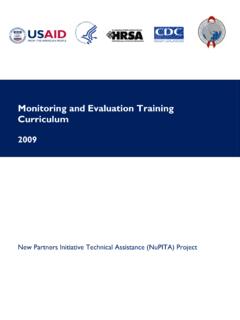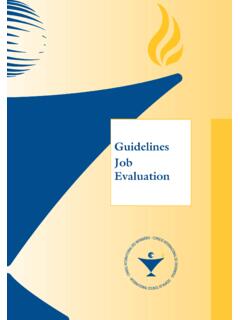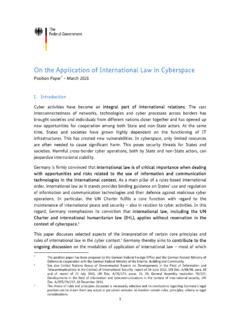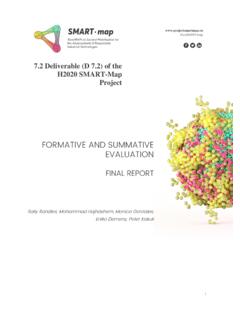Transcription of Impact Evaluation - GOV.UK
1 Prepared by Elliot Stern for the Big Lottery Fund, Bond, Comic Relief and the Department for International Development, May 2015 Impact EvaluationA Guide for Commissioners and Managers Impact Evaluation AcknowledgementsI would like to acknowledge the team that prepared the initial report for the UK Department for International Development (DFID) on which this guide builds. This team included Nicoletta Stame, Kim Forss, Rick Davies, Barbara Befani and John Mayne as well as the author of this guide. Two members of this original team (Barbara Befani and John Mayne) have also acted as sounding boards during the preparation of this impetus for this guide came from a cross-funders group interested in helping decision-makers within civil society organisations and those that fund them to better understand how to commission, manage and use Impact evaluations.
2 Members of this cross-funders group drawn from Bond, Comic Relief, the Big Lottery Fund and DFID have offered helpful advice and support throughout part of the drafting process a workshop was convened by Bond that brought together those involved in over 20 CSOs together with funders to explore the IE context as they understood it and to suggest issues that the guide should cover. Those who participated in this workshop also contributed examples of IE related material that has further informed this Stern May 2015 Big Lottery FundBig Lottery Fund (BIG) is one of the largest grant-making organisations in the UK and is responsible for distributing 40 per cent of all funds raised for good causes by the National Lottery.
3 BIG distributes funds to both UK and International charities, voluntary and community sector is the UK membership body for organisations working in international development. We work to influence governments and policy-makers, develop the skills of people in the sector, build organisational capacity and effectiveness, and provide opportunities to exchange information, knowledge and ReliefComic Relief is a major grant-making charity based in the UK which gives grants to both UK and International charities, with the aim of bringing an end to global for International DevelopmentThe Department for International Development (DFID)
4 Is the ministerial department leading the UK s work to end extreme poverty. 1 Impact Evaluation Contents1. Introduction and scope 22. What is Impact Evaluation ? 4 Defining Impact and Impact Evaluation 4 Linking cause and effect 5 Explanation and the role of theory 7 Who defines Impact ? 7 Impact Evaluation and other Evaluation approaches 8 Main messages 93. Frameworks for designing Impact Evaluation 10 Designs that support causal claims 10 The design triangle 11 Evaluation questions 11 Evaluation designs 13 Programme attributes 14 Main messages 154.
5 What different designs and methods can do 16 Causal inference: linking cause and effect 16 Main types of Impact Evaluation design 20 The contemporary importance of the contributory cause 21 Revisiting the design triangle 21 Main messages 235. Using this guide 24 Drawing up terms of reference and assessing proposals for Impact evaluations 25 Assessing proposals 25 Quality of reports and findings 27 Strengths of conclusions and recommendations 28 Using findings from Impact evaluations 29 Main messages 29 Annex 30 2 Impact Evaluation 1.
6 Introduction and scopeAll those who are involved in practical development work whether nationally or internationally face demands for Impact Evaluation . Funders, stakeholders and the public at large want to know that funds are used to good effect: that they achieve results and improve the lives of people and their communities. Impact Evaluation (IE) seeks to demonstrate that intended results follow from programme activities whether directly or indirectly. Whilst Evaluation of development programmes is nothing new, the focus on Impact has been given greater urgency by resource constraints and political demands for more accountability and transparency.
7 These demands come not only from funders but also from those affected by development programmes often the most poor and marginalised who want to know that greater resources, rights and services will genuinely follow from their engagement with development this background, various approaches to IE are advocated many accompanied by claims by experts that theirs is the best or only way. One of the problems 3 Impact Evaluation 1. Introduction and scopefaced by those who need to decide how to approach demands for IE, is that it is often presented as a technical or methodological question only accessible to experts or researchers.
8 To some extent this is true but the main arguments, logics and choice-points are more accessible. This is because the choice of IE designs should be based not on advocacy for particular methods but on practical considerations that face those who commission, manage and fund development programmes. These policy-makers and managers need to decide what they hope to get out of an Evaluation , how this relates to the kinds of programmes or initiatives they are involved with, and what are the realistic capabilities of designs and methods on offer.
9 This is the starting point of this guide, the purpose of which is to support managers and commissioners of Impact evaluations to better manage the entire process from drawing up terms of reference, selecting contractors, steering evaluations and utilising Evaluation results. The guide also argues that relying only on traditional approaches to IE does not fit well with the kind of customised, complex, locally engaged and often sensitive programmes that non-governmental organisations (NGOs) and civil society organisations (CSOs) undertake.
10 A broader range of designs and methods are design guide , as the title suggests, starts from the assumption that: Evaluation design is a vital stage in the overall Impact Evaluation process. If neglected, it will have negative consequences down the line in terms of the relevance, validity and usability of Evaluation outputs. It is important for those who commission, manage and use Impact Evaluations to have access to frameworks and guidance. These allow them to ask the right questions of the specialist evaluators who will in the end do the IE work that is audience for this guide are those who.

















